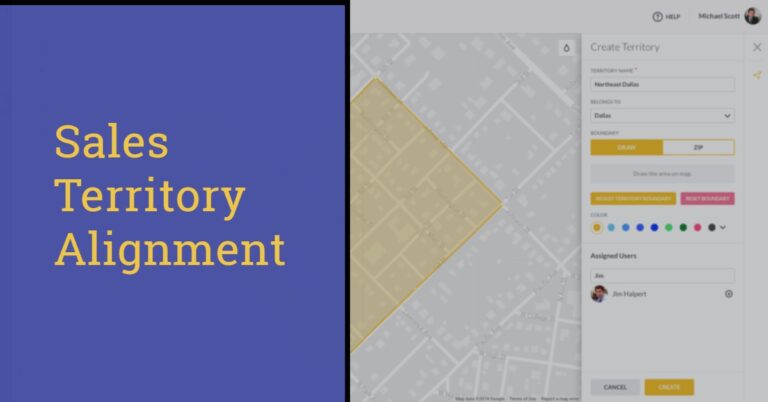A proper sales territory strategy is crucial to success in field sales. Once you have one, your entire team will become more efficient, achieve better results, and enjoy their work more.
Of course, to build an effective sales territory strategy, you have to understand and invest in sales territory alignment. So that’s what we’re going to talk about today.
Keep reading to learn what sales territory alignment is, why it can be so beneficial, when to conduct a territory alignment for your own company, tips to make sure you do it right, and more.
What Is Sales Territory Alignment?
Sales territory alignment is the process that sales departments go through when they decide they want to redistribute their current sales territories amongst their existing sales reps.
There are many reasons why you might want to invest in territory alignment. We’ll cover a few of them in the section below. For now, just know that sales territory alignment can lead to greater productivity, happier customers, and higher profits. In other words, all of the things you want!
What Are The Benefits of Sales Territory Alignment?
As we alluded to above, there are a bunch of benefits to sales territory alignment.
The main one is greater team-wide efficiency. But you’ll enjoy many more when you optimize your territories—guaranteed. Here are four other benefits you’re likely to experience:
Reduced Travel Time
When your sales territories are properly aligned, your sales reps won’t have to travel as far between appointments. This will decrease their windshield time, making them more productive.
As an added bonus, reduced travel time almost always translates to fewer expenses. After all, if your reps don’t have to drive great lengths, they won’t spend as much money on gas. We’ll dive deeper into the profitability potential of sales territory alignment in a minute. First…
Optimized Resource Utilization
Your sales team has a finite amount of resources, which is why you need to optimize the way you spend them. Doing so will lead to better results across a wide array of important metrics.
Territory alignment typically leads to improved allocation of resources because it encourages sales teams to prioritize top leads, cut back on unnecessary expenses, and otherwise make the most of their reps’ individual efforts.
Improved Customer Satisfaction
While sales territory alignment will help you via reduced travel time and proper resource utilization, it will also help your target audience.
Your reps will be able to give each potential customer the time they deserve, rather than rushing off to the next appointment. When this happens, your company’s bottom line will improve.
Increased Profitability
Speaking of your bottom line, territory alignment can impact it in a significant way.
For example, you won’t over hire and then have to pay for reps who don’t contribute in meaningful ways. Or have to pay exorbitant gas prices so reps can criss-cross their too-large territories over and over again. These things will increase profitability for your organization.
When To Conduct a Territory Alignment
Sales territory alignment is obviously beneficial. The question is, when should you do it? There are three specific times that you should consider implementing this process for your sales team:
Sales Team Changes
Sales teams change on a regular basis. New reps come into the fold, old reps leave for greener pastures. Sometimes companies merge and multiple sales teams are asked to join forces. When these kinds of changes occur to your sales team, consider a territory alignment.
New Company Strategy
What if your sales department adopts a new target audience? Or crafts a new sales strategy to reach a current audience? Both of these scenarios should lead to a sales territory alignment.
Shifting Trends or Competition
New trends, like the dramatic uptick in remote work that we experienced in 2020, can be cause for territory alignment, too. As can a change in your competition. Perhaps an old competitor has stopped selling products in your area. You may need to align your territories to fill the vacuum.
Essential Components of Sales Territory Alignment
You can’t just decide to randomly align your sales territories. You need access to a few important pieces of information and/or tools. Here are four essential components to plan for:
- Territory Maps: Don’t embark on any sales territory alignment task without a way to visualize the territories you’ll create. Fortunately, there are tons of apps to help with this. SPOTIO, for example, will help you visualize and assign territories in seconds.
- Account Charts: Your sales reps need to know which leads they’re responsible for. Account charts give them this information, allowing reps to see who they’re responsible for, whether the lead has been contacted in the past, the result of that contact, etc.
- Cost Analysis: How much will it cost you to align your territories? Don’t forget to consider sunk costs and opportunity costs. Then determine how much money your company will save by territory alignment. These metrics are useful to have on hand.
- Industry Data: Finally, gather data on trends, competitors, and other industry factors. That way you can track them during the sales territory alignment process and make sure they don’t affect your efforts in a negative way.
Try These 5 Steps For Optimal Sales Territory Alignment
So, how do you actually realign your territories? This process below will help. Just follow these five steps and you’ll be able to successfully conduct a sales territory alignment for your team:
Gather Your Data
First, collect as much data as you can. You want to know things like the number of salespeople at your disposal, the accounts they currently oversee, the frequency with which they engage with these accounts, and the estimated time each engagement requires.
Data regarding your target audience and competitors can be beneficial, too. Basically, gather information on as many aspects of your team’s sales process as you can.
Analyze Your Territories
Next, analyze your current territories. What’s wrong with them?
Some of your territories might be too big, while others are too small. Some territories might naturally lend themselves better to specific industries—industries you’re not currently pursuing.
Take a look at the territories you already have to see how they can be improved.
Assess Your Sales Team Strengths
Now look at each of your reps’ individual skill sets. Where do they excel? When you know the answer to this question, you can assign them to territories that match their strengths.
For example, a territory with multiple enterprise companies should be assigned to a rep who has experience closing deals with enterprise brands. A territory with residential customers, on the other hand, should be assigned to a rep who thrives in those kinds of sales situations.
Align Your Territories and Team
Next, cut territories that make sense for your sales team.
Make sure they’re not too small, as this won’t allow reps an adequate number of leads to pursue. But don’t make them too large either. This will make reps feel overwhelmed and generate poor results.
Also, do your best to cut territories in a way that groups like buyers together. This may not be possible for every organization. But if a specific area in your city caters to industrial-type business, for instance, you probably shouldn’t put it in the same territory as a bunch of residential houses.
Once you’re happy with the territories you’ve created, assign them to the most qualified reps.
Manage and Realign Regularly
Finally, keep your finger on the pulse of your industry and the individual territories you’ve assigned to your team. Then look for new opportunities for sales territory alignment. This kind of vigilant approach will help you and your team close more deals and avoid missed opportunities.
How Sales Territory Mapping Software Can Help
Sales territory mapping software makes it easy to visualize, cut, and assign sales territories.
Apps like SPOTIO let you view digital maps on your mobile device or desktop computer, then enable you to divide them into custom territories by using zip codes or drawing with your finger.
Many territory mapping apps can also integrate with CRM software and pull in relevant data. For example, a medical supplies salesperson can cut territories based on the number of hospital beds in a given area—information that is likely available in the seller’s CRM of choice.
Finally, sales territory mapping tools make it easy for reps to see where their territories start and end, and which prospects belong to them rather than one of their colleagues. This level of clarity keeps sales teams on the same page and minimizes the potential for inner-team turmoil.
Improve Your Success With SPOTIO’s Sales Territory Alignment Solution
Sales territory alignment is an important process—ignore it at your own peril.
Once you agree to align (or realign) your territories, your reps will be more proactive, your customers will be happier, and your bottom line will look a lot better.
To align your territories the right way, invest in a sales territory alignment solution. SPOTIO is a popular option in this regard because it’s easy to use, yet extremely powerful. Use the platform to visualize and cut territories, map individual customers, and improve your decision making.
In addition, SPOTIO can be used to generate leads, set appointments, design optimal travel routes, communicate with prospects via email and text, automate tasks, and generate reports.
Request a free demo of SPOTIO today to see if our industry-leading solution is right for you.



